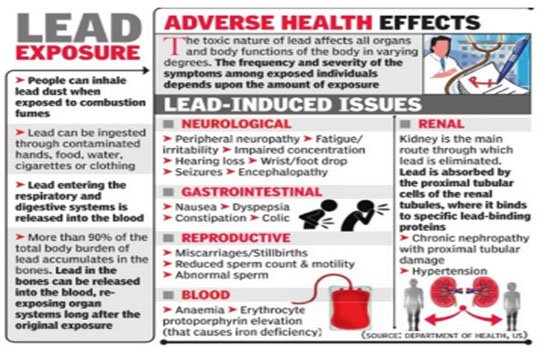LEAD POISONING

- According to a report by Niti Aayog and the Council of Scientific and Industrial Research (CSIR), lead poisoning causes the greatest health and financial burden in India.
MORE ABOUT THE NEWS
- Scientists have been aware that the naturally occurring metal has no biological function that can benefit the human body.
- It can cause devastating physical and developmental impacts.
- Despite the awareness, lead toxicity continues to be a public health concern.
- Half the children in India report high blood lead levels, reveals a 2020 report by the UN Children’s Fund (UNICEF) and Pure Earth.
- The report says 275 million children in India record blood lead levels beyond the tolerable limit of 5 µg/dL.
- Of these, 64.3 million children’s blood lead levels exceed 10 µg/dL.
DEBILITATING IMPACTS OF LEAD POISONING

- The adverse impacts of lead entering the human body have been known since 1920.
- The Industrial Revolution caused an epidemic of metal intoxication, urging scientists and physicians of that period to study and identify specific symptoms and organ alterations related to chronic lead poisoning,” says a 2012 study published in the journal Safety and Health at Work by researchers from Italy.
- In a newborn, lead poisoning can result in problems such as : premature birth, low birth weight and slow growth.
- In children and adults, it can cause anaemia as well as neurological, skeletal and neuromuscular illnesses.
- The UNICEF-Pure Earth report says children with elevated blood lead levels scored three-five points lower on intelligence tests.
- This “permanent damage (affects) a child’s brain development and central nervous system causing reduced intelligence, attention deficit disorders and lower educational attainment.
Common sources of Lead exposure include:

- Water containing lead due to the usage of lead pipes
- Lead batteries’ improper disposal
- Lead paints
- Lead oxides in glass and ceramics
- Ammunitions
- Lead-based paints
- In fuels like petrol, diesel
CONDITION OF INDIAN STATES

- India, in contrast, has recorded a 21 per cent increase in deaths caused by lead exposure since 1990.
- Bihar, Uttar Pradesh, Madhya Pradesh, Jharkhand, Chhattisgarh, and Andhra Pradesh are the states most severely impacted.
- In terms of average blood lead levels among the population: 23 states exceed the 5 µg/dL margin.
- Remaining 13 states and Union Territories cannot be determined as there is a lack of research and screening mechanisms to collect data.
- In India, it could be due to the fact that lead does not get as much attention as other potential public health concerns.
- The country also lacks systems to screen populations for possible exposure.
- India has some 48 national referral centres for lead projects where blood lead levels can be tested, but screening is usually done on a voluntary basis or at health camps by non-profits.
CASE STUDY- LEAD POISONING OF FOOD MATERIALS IN INDIA

- Spices are the only identified sources of lead poisoning, as per experts.
- In northeastern states, the high moisture content does not allow for turmeric in the region to dry quickly, resulting in a lighter colour.
- This turmeric is transported to Bihar and West Bengal, where lead is added to the commodity to bring out a deeper yellow colour.
- The Food Safety and Standards (Food Products Standards and Food Additives) Regulations, 2011, says the threshold for lead in food of 10 PPM.
- The highest levels of lead was found in chilli powder and turmeric powder, which greatly exceeded the permissible amounts.
GLOBAL CONCERN
- Blood lead levels (BLL) in children of up to 800 million worldwide are at or above 5 micrograms per deciliter (g/dL).
- The UNICEF-Pure Earth report notes around one in three children worldwide record blood lead levels of over 5 µg/dL.
- Countries with this burden include Iran, Afghanistan, Yemen, Peru, Vietnam, the Philippines and parts of Central Africa.
- Many nations don’t have enough official recycling infrastructure or capacity to deal with the volume of spent lead-acid batteries that are saturating their marketplaces.
STEPS TO FIGHT THIS MENACE
- Regular screening and testing of lead sources will inform about region-wise prevalence and help tailor interventions, such as:
- Regulations and enforcement.
- Changes in industry practices.
- Training of government officials to assess lead contamination.
- Changes in public education and consumer behaviour.
- Enhancing the capacity for testing, currently done for blood lead levels.
- Given the grave implications for health, national and state policy changes are urgently needed.
- Protect workers from toxic metal exposure under the Occupational Safety and Health Administration (OSHA) Regulations.
- Ensure safe and environmentally sound recycling of lead-acid batteries.
- There is a need to study the potential presence of lead in other foods as by looking at the case of spices.
SOURCE : MILLENIUM POST
SYLLABUS : MAINS, GS 3 ENVIRONMENT


